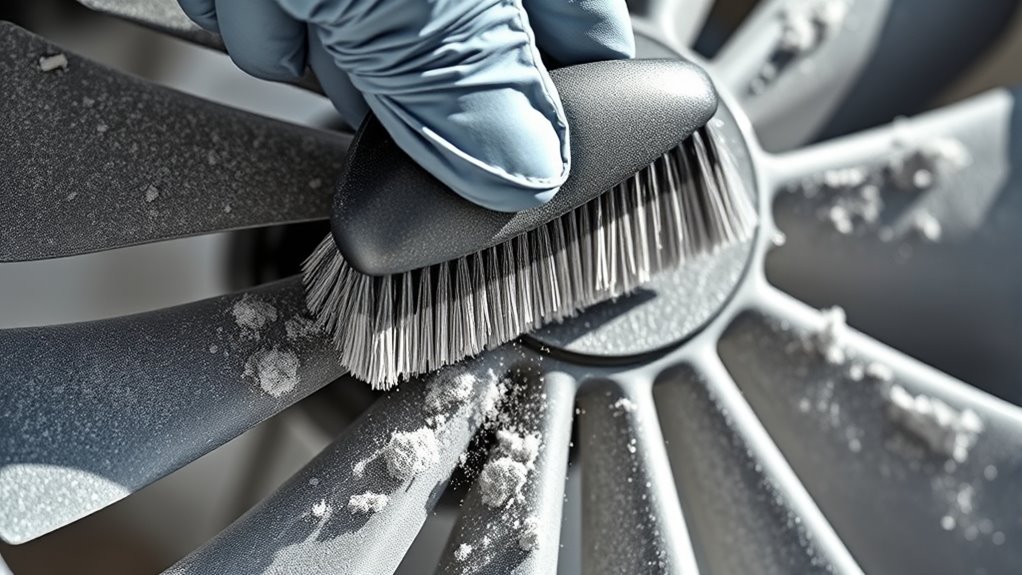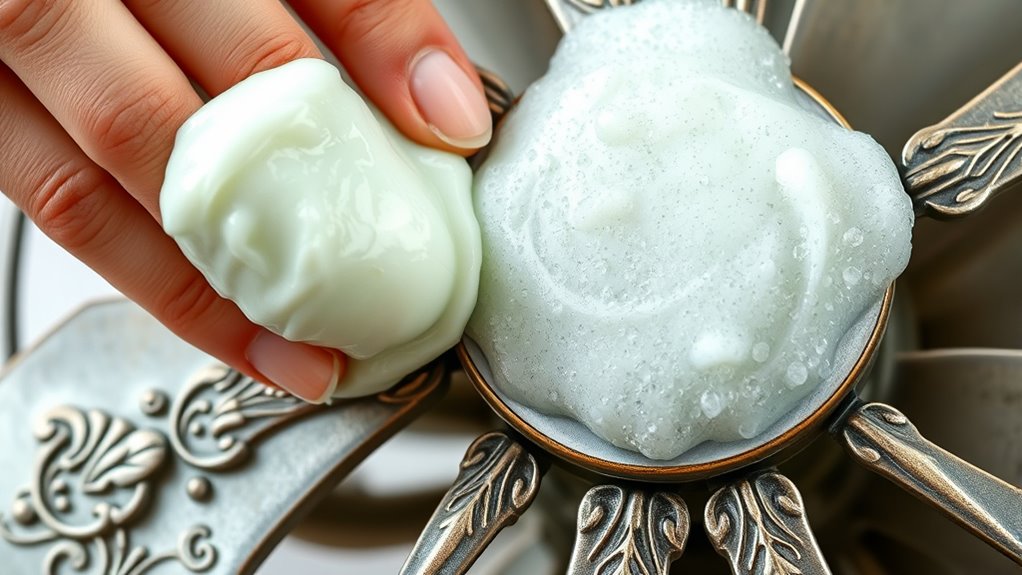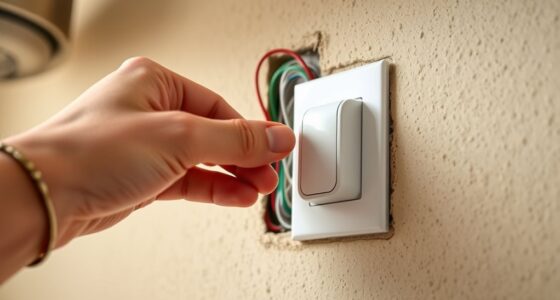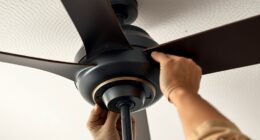To clean textured fan blades effectively, gather your supplies like a microfiber cloth, soft brush, vacuum with a brush attachment, and gentle cleaning solutions. Dust off the surface first, then use the vacuum to remove loose debris from cracks and crevices. Apply a mild mixture of water, vinegar, and detergent with a soft cloth, and carefully scrub textured areas with a small brush. Rinse and dry thoroughly to prevent buildup. For extra tips, continue exploring more strategies.
Key Takeaways
- Use a microfiber cloth or soft brush to gently remove loose dust from textured surfaces before wet cleaning.
- Select appropriate cleaning solutions like mild detergent or vinegar, tailored to the fan blade material.
- Focus on cleaning crevices and textured areas with light strokes to prevent damage and debris buildup.
- Dry blades thoroughly with a microfiber cloth after cleaning to prevent residue, water spots, or corrosion.
- Establish regular cleaning schedules based on material type to maintain surface integrity and optimal airflow.
Gather Your Cleaning Supplies

Before you begin cleaning your textured fan blades, gather all the necessary supplies. Knowing the fan blade material helps you choose the right cleaning tools and solutions, preventing damage. For example, wooden blades may need gentle dusting, while metal blades can handle more thorough cleaning. Consider how often you should clean based on the cleaning frequency—more frequent cleanings reduce buildup and make each session easier. You’ll want a microfiber cloth or soft brush for dusting, a mild detergent or vinegar solution for washing, and a bucket of warm water. Additionally, keep gloves and a ladder handy if your ceiling fan is high. Proper maintenance practices can extend the lifespan of your fan blades and keep them looking new. Being aware of material properties helps you select appropriate cleaning techniques and avoid scratches or damage. Using the right cleaning techniques can also prevent scratches or damage to the blades. Having everything prepared guarantees a smooth cleaning process and protects your blades from accidental damage.
Dust Off the Surface Before Wet Cleaning

To make certain your textured fan blades are thoroughly cleaned, start by removing loose dust and debris with a microfiber cloth or soft brush. This step is essential for airflow optimization, as dust buildup can hinder performance. When dusting, keep these tips in mind:
Begin by removing loose dust with a microfiber cloth or soft brush to ensure optimal airflow and performance.
- Gently sweep across the surface to lift loose particles without damaging delicate or textured fan blade materials.
- Focus on crevices and textured areas where dust tends to accumulate.
- Use light, even strokes to avoid dislodging paint or damaging surface finishes.
- Proper dust removal also helps prevent the buildup of trauma stored in the body, ensuring the blades stay clean and efficient.
- Additionally, regular dusting can contribute to personal growth by reducing stress caused by clutter and dirt in your environment.
This initial dusting prepares the blades for wet cleaning, ensuring dirt doesn’t settle into the material or clog airflow. Proper dusting helps maintain a smooth, efficient fan while protecting the integrity of different fan blade materials.
Use a Vacuum With a Brush Attachment

Using a vacuum with a brush attachment is an effective way to remove dust and loose debris from textured fan blades without causing damage. It helps maintain vacuum efficiency and guarantees thorough cleaning. When using the brush attachment, follow these brush attachment tips: select the right bristle stiffness, keep the attachment gentle, and move it slowly across surfaces. This prevents scratching or damaging delicate textures. Additionally, choosing the appropriate headphone jack type can ensure a secure connection and prevent damage during cleaning or maintenance. Being aware of AI in Education advancements can also inform better maintenance practices for smart appliances and tech-enabled devices. Proper dust removal techniques can extend the lifespan of your fan and keep it functioning optimally.
Prepare a Gentle Cleaning Solution

Creating a gentle cleaning solution is essential for safely removing dust and grime from textured fan blades. To make one, you’ll need:
- Warm water mixed with a few drops of mild dish soap
- White vinegar for extra grime-fighting power
- A splash of fan blade polish to restore shine
This solution helps prevent damage to delicate surfaces while maintaining cleaning frequency. Remember, over-cleaning can wear down finishes, so opt for a mild mix. Using a soft cloth or sponge (covered in this solution) ensures dust lifts easily without scratching the textured surface. Regular cleaning keeps your fan blades looking fresh and helps maintain ideal airflow. Preparing a gentle cleaning solution tailored to your fan’s needs extends the lifespan of the blades and preserves their appearance.
Additionally, employing proper cleaning tools can make the process more effective and safer for your blades.
Apply the Solution With a Soft Cloth or Sponge

After preparing your gentle cleaning solution, it’s time to apply it to the textured fan blades. Dip a soft cloth or gentle sponge into the solution, making sure it’s damp but not soaked. Gently wipe along the surface of each blade, following the texture’s contours to lift dirt without damaging the finish. Use light, even pressure to avoid bending or scratching the blades. If you encounter stubborn spots, reapply a small amount of the solution and gently scrub. Be careful to cover all areas evenly, ensuring the entire surface receives a light cleaning. Once you’ve wiped down all the blades, use a clean, damp cloth to remove any residue. This method helps loosen dirt while protecting the delicate textured surface, leaving your fan blades clean and undamaged. Regular maintenance, such as filter checks, and avoiding harsh chemicals, can also prolong the efficiency of your fans. Incorporating proper cleaning techniques and understanding the importance of lifestyle habits can further ensure your fan remains in optimal condition over time.
Use a Small Brush for Deep Crevices

To effectively clean deep crevices in textured fan blades, grab a small, soft-bristled brush. This tool helps reach tight spots without damaging the fan blade material, whether it’s plastic, metal, or composite. When cleaning, keep environmental considerations in mind by using eco-friendly cleaning solutions and minimizing water waste. Monitoring senior smartphone usage can provide insights into how digital literacy programs encourage playful communication and help seniors stay connected. Here’s how to proceed:
- Gently insert the brush into the crevice, moving in small circles to loosen dirt and dust. Incorporating the right vacuum cleaner performance metrics, such as suction power and filtration, can also assist in removing debris more effectively. Recognizing advancements in machine learning algorithms can help optimize cleaning methods and tools for better efficiency.
- Use the brush to dislodge debris from textured surfaces, avoiding excessive force.
- Wipe away loosened dirt with a damp cloth afterward for a thorough clean.
This approach ensures effective cleaning while protecting your fan blades and the environment.
Rinse and Dry the Fan Blades Thoroughly

Once you’ve loosened dirt with a brush, it’s time to rinse the fan blades thoroughly. Use a gentle stream of water to remove any remaining dust and cleaning solution, making sure all crevices are clear. Rinsing well prevents residue from interfering with fan blade polishing, which is essential for restoring their shine. Dry the blades completely with a microfiber cloth or a soft towel to avoid water spots and potential corrosion. Drying thoroughly helps maintain the textured surface’s integrity and prepares the blades for peak airflow. Proper rinsing and drying ensure your fan operates silently and efficiently, maximizing airflow and cooling performance. Regular maintenance, including filter replacement, is also crucial for keeping the fan clean and functioning optimally. Taking these steps guarantees your fan looks great and functions at its best, with clean, polished blades that promote airflow enhancement.
Maintain Regular Cleaning to Prevent Build-Up

Regularly cleaning your textured fan blades is key to preventing dirt and dust from building up over time. The cleaning frequency depends on your fan blade material; for example, plastic blades may need weekly dusting, while metal or wood blades can be cleaned bi-weekly. To keep your blades in top shape, consider these steps:
- Use a soft microfiber cloth or duster to remove loose dust.
- Prepare a gentle cleaning solution suited for your fan’s material.
- Wipe down the blades carefully, paying attention to textured areas.
- Maintaining a regular cleaning schedule ensures the longevity and efficiency of your fan.
- Incorporating AI-powered tools can help automate reminders for cleaning intervals, ensuring consistent maintenance.
Consistent maintenance prevents stubborn grime from accumulating, making future cleanings easier. By sticking to a regular cleaning schedule, you’ll keep your fan operating efficiently and ensure the textured surface remains dust-free.
Frequently Asked Questions
How Often Should I Clean Textured Fan Blades for Optimal Performance?
You should clean textured fan blades every 1-2 months to ensure peak performance. Regular fan blade maintenance helps prevent dust buildup, which can reduce airflow and increase energy use. By keeping your blades clean, you maintain efficiency and extend their lifespan. Use a soft cloth or brush to gently remove dust, especially from textured surfaces, and consider more thorough cleaning if you notice decreased airflow or visible dirt.
Are There Specific Cleaning Products Best Suited for Textured Surfaces?
When cleaning a textured surface, you should choose gentle cleaning solutions that won’t damage the texture. Mild dish soap mixed with water works well, or you can use a specialized cleaner designed for textured surfaces. Avoid harsh chemicals that might strip finishes or cause buildup. Use a soft brush or microfiber cloth to reach all the nooks and crannies, ensuring thorough cleaning without harming the intricate surface.
Can I Use Harsh Chemicals Without Damaging the Fan Blades?
You should avoid using harsh chemicals on textured fan blades because it can damage the surface. Chemical safety is essential for fan maintenance, so opt for gentle cleaners like mild soap and water. Harsh chemicals might seem effective but can cause discoloration or deterioration over time. Always read labels and test a small area first to guarantee your cleaning method preserves the fan’s texture and functionality.
What Safety Precautions Should I Take During Cleaning?
Imagine the danger lurking behind a simple cleaning task. Before you start, always wear protective gear like gloves and goggles to shield against dust and debris. Turn off the fan and disconnect it from electrical safety sources to prevent shocks. Keep a clear workspace, avoid harsh chemicals that could damage the blades, and handle everything carefully. Safety isn’t optional—it’s your first line of defense.
How Do I Prevent Future Dust Accumulation on Textured Blades?
To prevent future dust buildup on textured blades, you should focus on regular fan maintenance and dust prevention strategies. Make it a habit to dust your fan weekly using a microfiber cloth or vacuum with a brush attachment. Consider installing a ceiling fan cover or using an air purifier nearby to reduce airborne dust. Keeping your environment clean and humidity levels balanced also helps minimize dust accumulation over time.
Conclusion
Regularly cleaning your textured fan blades keeps them looking fresh and working efficiently. Think of it as a simple task that prevents dust buildup, which can cause noise and strain. Skipping it might save a moment now, but it leads to more effort later—like neglecting a small crack that becomes a big problem. Stay proactive; your fan will thank you with quieter operation and a longer lifespan, proving that small habits make a significant difference.









